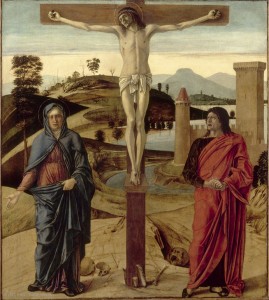Cultural Cocktail Hour
Two MUST SEE EXHIBITS: “Giovanni Bellini” and “Sacred Landscapes” at the Getty Center
By
Leticia Marie Sanchez
Imagine being able to teleport yourself through time and space to imagine life as a spiritual Venetian noble in the 15th Century. Or as a believer in 15th Century Bruges.
Two intriguing exhibits at the Getty Center allow museum goers to take those journeys.
Firstly, Giovanni Bellini: Landscapes of Faith in Renaissance Venice offers insight into the work of a Venetian master.
What is astounding about this exhibit is that it is the first monographic exhibition in America devoted to Giovanni Bellini. This gifted and prolific artist, who when he was already in his seventies, was praised by Albrecht Durer as “still the best in the art of painting” despite the fact that Titian and Giorgione were already on the scene.
In one room, viewers are fortunate to be able to view Bellini masterpieces loaned from museums and private collections in Paris, Florence, Venice, and around the globe.
The Bellini exhibit underscores the vitality of an Encyclopedic Museum like the Getty Center. Viewers who may not be able to procure plane tickets to Venice, Florence, and Paris at the drop of a hat now have the opportunity to obtain an instant artistic passport to these places by virtue of this exhibit.
The passport that one obtains is not only geographical, but also allows one to understand the historical context.
For instance, one learns that the paintings in the Bellini exhibit were meant for private devotion for a group of Venetian nobles. These collectors were influenced by the Italian Renaissance humanist Petrarch, whose treatise “De Vita Solitaria” contrasted the corrupting consequences of doing business in an urban center with the restorative process of meditating in solitude. Many patricians recognized the importance of taking a step away from their busy lives to meditate.
Davide Gasparotto, who expertly curated this beautiful exhibit, describes the Bellini paintings as “meditational poems” of real and ideal landscapes.
Bellini often painted St. Jerome, a figure who conflated two traditions: the hermit in the desert and the scholar. For example, in Bellini’s 1485 painting “St. Jerome Reading In The Countryside,” St. Jerome is removed from the sinful city which is featured in the top half of the painting. The perspective shows St. Jerome centrally seated in a remote, desert-like space, linking him with other hermetic Biblical figures like St. Francis and John the Baptist. (There are several paintings of St. Jerome in the exhibit- don’t miss them!)
Giovanni Bellini
Saint Jerome Reading In The Wilderness.
(Venice ca 1435-1516)
ca 1485. London, National Gallery,
Image Courtesy of the Getty Center.

Perspective also plays a key role in Bellini’s “Crucifixion With the Virgin and Saint John the Evangelist.” Bellini painted the cross on a threshold between the painting itself and the viewer, connecting this image to the audience in a impactful and uniquely visceral way.
Giovanni Bellini.
Crucifixion With the Virgin and Saint John the Evangelist.
Venice.ca 1465, panel.
Image Courtesy of the Getty Center.

These unusual perspectives as well as the paintings’ relatively small size allows us to imagine ourselves in the room of a 15th Century Venetian patrician. Unlike their Florentine counterparts, the majority of Venetian patricians did not have chapels in their residences, so Bellini’s paintings would have hung in their rooms for private devotion.
Just as the Bellini exhibit takes us on a trip to 15th Century Venice, a second complementary exhibit, “Sacred Landscapes: Nature in Renaissance Manuscripts” takes us on a journey through France, Belgium, Germany, England, and Italy.
This exhibit, beautifully curated by Bryan C. Keene and Alexandra Kaczenski seamlessly connects with the Bellini exhibit on a thematic and visual level. For instance, the image of St. Jerome appears in both. Both exhibits feature nature as spiritual mecca, a theme that harkens back to the Garden of Eden, in which a verdant space epitomizes paradise.
But “Nature in Renaissance Manuscripts” takes visual meditation a step further.
Many of these books of prayer were used by those saying the rosary. So the second exhibit connects us to the active pilgrim, one who holds the devotional manuscript contemplating blooming roses while grasping rosary beads in one’s fingers. These books connect the visual with the tactile.
What is even more illuminating about this exhibit is uncovering the meaning behind the vibrant images of flowers embedded in the margins of the texts- rich floral details which provide clues as to scientific philosophies at the time.
For instance, in the image of The Visitation by the Master of the Dresden Prayer Book Mary visits her cousin Elizabeth in which they mutually share their blessed news of being with child. Bordering the image and text of this joyous scene are depictions of pansies, strawberries, columbines, and forget-me-nots. Not coincidentally, these plants were used during this era as a form of pain medication for the pangs of childbirth. The images of fruit have a double meaning. In the “Hail Mary” prayer, Jesus is referred to as “the fruit” of Mary’s womb. By carefully observing these exquisite pages, one can learn much about both the religious and scientific attitudes of the time.
The Visitation.
Bruges, Belgium ca 1480-85
Master of the Dresden Prayer Book or workshop
Crohin-La Fontaine, Hours. 1
3.3 X 9.4 cm. MS 23 (86) ML. 606) fols. 71v-72.
Image Courtesy of Getty Center.

Each page of these illuminated manuscripts offers a teachable lesson about botany, religion, or medicine, and often all three simultaneously. Most importantly, they capture a moment in time.
Both of these exhibits, one devoted to a Venetian master and the other a journey to arboreal splendor are MUST-SEES.













